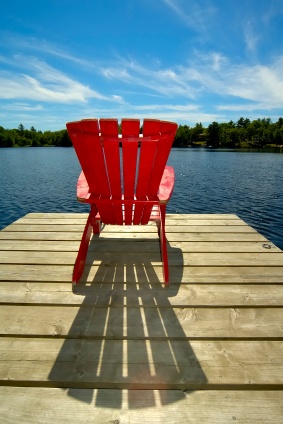David Larock in Home Buying, Mortgages and Finance
Happy belated Canada Day! This past weekend as I wound my way north up to cottage country, I  was thinking of ideas for this week’s post (taking the 400 out of Toronto on a long weekend gives you plenty of time to do this). My first inclination was to write about the new HST changes impacting mortgages and lending, but since partnering with a mortgage planner doesn’t cost you anything (in tax or otherwise) it seemed too short for a post. Instead, given the fabulous weather we enjoyed across southwestern Ontario this past weekend, I thought it would be a good time to write about mortgage financing for vacation properties and second homes.
was thinking of ideas for this week’s post (taking the 400 out of Toronto on a long weekend gives you plenty of time to do this). My first inclination was to write about the new HST changes impacting mortgages and lending, but since partnering with a mortgage planner doesn’t cost you anything (in tax or otherwise) it seemed too short for a post. Instead, given the fabulous weather we enjoyed across southwestern Ontario this past weekend, I thought it would be a good time to write about mortgage financing for vacation properties and second homes.
First let’s explain the difference between these two property types. A vacation property is for recreational use and can come in many forms: cottage, ski chalet, cabin etc. A second home is used more traditionally, for example, as a pied-à-terre for long commuters and retirees, or as a university residence for children who would otherwise rent. In both cases, lenders assume that the buyers of the property will either use it themselves, or allow it to be used by family members on a rent-free basis (if the property is being used to derive income then it is classified as a rental and a different set of rules apply). While you’ve probably seen both terms, maybe with a different-coloured pamphlet for each, in reality you’ll find that vacation properties and second homes are treated the same by lenders and insurers alike. (For that reason, from now on I’ll just refer to them as second homes).
Second-home financing is considered a riskier overall transaction. The thinking goes that if borrowers can’t pay their bills, they will preserve their primary residence above all else, making secondary properties more vulnerable to default. To offset this, maximum mortgage amounts for second homes are capped at lower levels that usually vary between $600,000 to $700,000, depending on the property’s location and overall loan-to-value. Credit score standards are also raised, although not to a level that is restrictive for borrowers with average credit. The bigge st differences in lending policies between primary and secondary homes are based on the characteristics of the properties themselves.
st differences in lending policies between primary and secondary homes are based on the characteristics of the properties themselves.
Second homes vary from luxurious to rustic and lenders differentiate between those that would be marketable as primary residences vs. those that offer more limited, seasonal use. The two groups are commonly referred to as Type A and Type B. Because Type A properties can be marketed as either first or second homes, they are considered ‘prime’ and lenders do not limit their offerings to borrowers beyond the restrictions mentioned in the paragraph above. This means you can borrow up to 95% of a Type A property’s value on a purchase (or up to 90% for refinance), and your maximum amortization can be as high as 35 years. Type B properties still have to be acceptable and in good condition (indoor plumbing is a must!) but they can be seasonal and do not have to be accessible on a year-round basis or winterized (island cottages are a good example). Because Type B properties are less marketable, and because they can be left unattended for extended periods, these increased risks are offset by scaled-back lending policies. As a result, you can borrow up to 90% of a Type B property’s value on a purchase, but you cannot refinance and your maximum amortization period is limited to 25 years.
Even if your ideal vacation property is a little too rustic to qualify in either category, fear not. In many cases, if your credit is good you can refinance your primary residence (with much more flexibility) and use the equity to either buy your second home outright or make such a large down payment (35% or more) that a lender will do the deal based on the equity alone. If you are considering co-ownerships or fractional ownerships, keep in mind that these are much more difficult to finance because their ownership structures make them harder for the lender to liquidate in the event of default. In some cases, solutions are still available, but buyers should expect higher financing costs and should adjust their budget accordingly.
As always, an experienced, independent mortgage planner is an excellent resource who can  save you thousands of dollars during the second-home buying process. That’s money that will come in handy when you’re outfitting your new getaway. Or you could save up for a plane to avoid the 400 traffic altogether (although we don’t offer financing for aircraft…not yet anyway).
save you thousands of dollars during the second-home buying process. That’s money that will come in handy when you’re outfitting your new getaway. Or you could save up for a plane to avoid the 400 traffic altogether (although we don’t offer financing for aircraft…not yet anyway).
David Larock is an independent mortgage planner and industry insider specializing in helping clients purchase, refinance or renew their mortgages. David's posts appear weekly on this blog (movesmartly.com) and on his own blog (integratedmortgageplanners.com/blog). Email Dave




